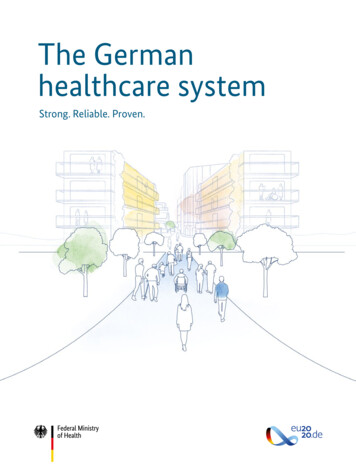
Transcription
The Germanhealthcare systemStrong. Reliable. Proven.
ForewordDear Readers,Across the world, healthcare systems are at the heart of efforts to cope with the currentCOVID-19 pandemic. Because a political response to mitigate the economic and socialconsequences of the pandemic will not be possible unless the spread of the coronavirusis stopped. A crisis like this reveals whether the existing structures and processes can standup to extraordinary pressures, and whether the actors involved have sufficient capacitiesand resources to provide the population with medical care and effectively fight infections for which neither a vaccine nor a treatment are immediately available. We must alluse this crisis to strengthen our resources where deficits have been exposed. Becausethere is certain to be another pandemic or a similar medical emergency in the future!At the same time, the COVID-19 pandemic has made it very clear that the challenges weface are not just a national matter. The virus does not stop at borders. The European andglobal dimensions of the crisis have especially been highlighted by the supply of medicinesand medical supplies and equipment.
From 1 July to 31 December 2020 Germany holds the Presidency of the Council of theEuropean Union and so will assume key responsibilities within the EU framework. Forthe health portfolio, this primarily means considering questions relating to the ongoingpandemic in their European perspective and learning the lessons that have to be learnt toensure that we in Europe are even better prepared in future.But there are also other urgent healthcare topics that are of great importance for thefuture of Europe and its ability to withstand crises. So during Germany’s Presidency ofthe Council of the European Union, we want to drive forward digitalisation and the useof big data and artificial intelligence in the health system, and we want to safeguardand improve the supply of pharmaceutical products and medical devices in the EU.Joint European solutions always work particularly well when they take national specificities into account. These specificities often go back a long way and mean that in manyareas the structures and processes in the member states differ from one another. Healthsystems in Europe have also adapted to the different national circumstances and conditions and so are different in themselves.This publication provides an overview of the German health system and explains its maininstitutions and regulatory mechanisms. We hope that it contributes to an understandingof the different healthcare systems in Europe. Because it is only with understanding forone another – especially in a medical emergency like the COVID-19 pandemic – that weand our partners in the EU and worldwide can ensure the medical treatment of citizens,improve our systems and create genuine added value in the context of the EU.Jens Spahn,Federal Minister of Health
Contents
A long history:the basic principles of the healthcare system6Multiple networks:the actors in the healthcare system14Dependable protection:statutory health insurance (SHI)22All-round support:medical and nursing care28Structurally dynamic:challenges and opportunities40German healthcare facts and figures48The Federal Ministers of Health from 1961 to today50Glossary51Reference sources54Information from the Federal Ministry of Health56Imprint61
A long history:the basic principlesof the healthcare system
Providing Germany’s population of 83 million with medical care is a massive task.Delivering this healthcare draws on a network of around 1,900 hospitals1, 150,000doctors2, 28,000 psychotherapists3 offeringoutpatient care and almost 19,500 pharmacies4. The costs of this healthcare system arehigh – more than 391 billion5 was spent onhealthcare in Germany in 2018 according tothe latest figures from the Federal StatisticalOffice. That is more than a billion euros aday. In other words, over one in ten eurosof Germany’s GDP goes on healthcare.The healthcare system is financed by statu tory and private health insurance. Today’ssystem has a long history. The first precursors of a mutual health insurance systemcan be found in the Middle Ages. Guildsand some companies assumed responsibility for financing medical and nursingcare for their members and employees.The different forms of social safety netthat evolved over the centuries were harmonised in the course of the 19th century.One milestone was the world’s first systemof social insurance introduced in 1883 bythe German chancellor at the time, Ottovon Bismarck. It laid the foundations forthe statutory health insurance system inGermany, which today covers most of thecountry’s residents.Healthcare inGermany is based onfive principlesMandatory insuranceStatutory health insurance (SHI) and privatehealth insurance (PHI) were made mandatory on 1 April 2007, and as of 1 January 2009everyone registered or usually resident inGermany is required to take out health insurance. Employees are required to makeSHI contributions if their income is belowa certain level (in 2020 the threshold was 5,212.50 per month). If their monthly income exceeds this level, employees canretain membership of the SHI on a voluntarybasis or elect to take out private health insurance. Some groups are also exemptfrom mandatory contributions to the SHIregardless of their income level. They include civil servants and the self-employed,for example.A networkincluding some 1,900 hospitals, 150,000 doctorsand 28,000 psychotherapists offering outpatientcare, as well as almost 19,500 pharmacies, provideshealthcare services to roughly 83 million peoplein Germany8
Financed by contributionsBoth SHI and PHI are funded by contributions or premiums from their members.Whereas contributions to PHI depend ona person’s health, the age at which theytake out the insurance, their individualrisk, the type of coverage and any excess,contributions to the SHI are based on aperson’s salary. With the SHI, all the insured receive the same level of services.Those who earn more pay higher contributions. This is what is meant by solidarityin the statutory health insurance system.The general contribution rate in the SHI is14.6 percent of salary, of which the employer pays half. Each insurance fund canalso charge an additional premium, whichcurrently averages around one percent andof which the employer also pays half.People insured privately may also be subsidised by their employer or pension fund.In the SHI, in contrast to the PHI, coverageis extended at no extra cost to the childrenand the spouse of the insured if they havelittle or no income. Health insurance contributions for those receiving unemployment or social security benefits are generally paid by the relevant benefits agency.83.3 yearsis currently thelife expectancy fornewborn girls.678.5 yearsis currently thelife expectancy fornewborn boys.69The basic principles of the healthcare system
30%of people in Germany go to thedoctor three to five times a year.7SolidarityThe German healthcare system is financedon the principle of solidarity. This meansthat all those with statutory health insurance bear the costs for the treatment of individual members. Everyone covered bySHI is entitled to medical care, regardlessof their income and therefore their healthinsurance contributions. So the healthypay for the sick, the rich for the poor andsingles for families. Another aspect of thissolidarity is that those in work continue toreceive their salary if they become ill. Employers pay them their full salary for thefirst six weeks. Anyone who is off workfor longer receives an allowance of 70 percent of their gross pay from their healthinsurance fund.No direct payment by patientsThose covered by SHI receive medical treatment without having to outlay the coststhemselves. Doctors, hospitals and pharmacies charge the cost of treatment andmedicines directly to the health insurancefunds. The insured are entitled to freetreatment, apart from any individual extracharges defined by law.The basic principles of the healthcare systemSelf-administrationThe health system is complex. It is characterised by conflicting interests, which haveto be aligned with one another: patientswant optimal treatment, doctors wantmodern technology and the health insurance funds have to ensure that they canfinance it all with the contributions theyreceive from the insured. Who has to coord inate it all? The state? The market? Or theindividuals involved?Germany has chosen the latter and appliesthe principle of self-administration. Thismeans that the state defines the framework for medical care and its responsibi l ities. It enacts legislation and regulationsfor this purpose. But how the system isorganised and structured in detail andabove all what medical treatments, oper ations, therapies and medicines are financedby the health insurance funds and thosethat are not are decided within the healthcare system. This self-administration ofthe healthcare system is carried out jointlyby representatives of doctors, dentists,psychotherapists, hospitals, health insurance funds and the insured. Its supremedecision-making body is the Federal JointCommittee (G-BA). Representatives of patient organisations have the right to tablemotions in and take part in G-BA sessions.The G-BA defines in binding guidelinesthe healthcare services to which thosecovered by statutory health insurance areentitled, e.g. what treatments are coveredby the statutory health insurance. As a rule,new medicines are covered.10
Classification of theGerman health systemComparing the health systems of variouscountries, they can be roughly dividedinto three categories: There are national health services organised by the state and funded from taxrevenue. This is the case in the UK andSweden, for instance. In these countries,all operations, therapies and medicinesare paid for from the governmentbudget. There may be extra charges forsome treatments. In these countries, it isthe state that organises the provision ofhospitals and healthcare centres too. Finally, there are market-based systems,in which the state plays a subordinaterole. The organisation and managementof the healthcare sector are functions ofprivate operators. Funding is also organised privately: there are private-sectorinsurance companies or people pay fortheir medical treatment themselves.They also have to cover their own cost ofliving if they cannot work for a longerperiod due to illness – there is no sickpay in this case. This is how it works inthe USA for example. In other countries, there are social insurance systems. Here, it is largely socialsecurity funds, i.e. health insurance funds,which finance medical care. They are financed by contributions from compan ies and employees, as is the case in Germany. Private and public providers operateside by side, in contrast to national healthservices. They regulate their interrelationships themselves, within a defined statutory framework. This is known as theprinciple of self-administration.Approximately 5.7million people work in the healthcare sector –ranging from doctor’s practices, to administrativefunctions to the pharmaceutical industry.811The basic principles of the healthcare system
The basic principles of the healthcare system12
Germany’s federalsystemWhen the coronavirus reached Germany,steps to combat the pathogen were takenon two levels: the Federal Governmentrecommended a policy of social distan cing for everyone in the country. The individual states then decided whether andwhen to close schools, museums and restaurants to protect people from infection.This was an example of the federal systemon which the Federal Republic of Germanyand as a result its healthcare system arebased. Close cooperation between theFederal Government and the individualstates forms the core of the federal system.The states participate in the legislativeprocess, including via the Bundesrat, andimplement federal laws.13To continue with the example of theCOVID-19 pandemic: the federal legislaturedefined the framework for protecting thepopulation in Germany. What authoritiestake action and how the regulations areimplemented in detail are then decided bythe states for their respective territories.The idea behind this is that politics shouldbe as devolved and as local as possible. Forthis reason, state responsibilities in Germanyare divided according to the principle ofsubsidiarity: first, the municipalities areresponsible for their local residents, then thestates, or Länder. The Federal Governmentsets out the policy framework in certain areas.The basic principles of the healthcare system
Multiplenetworks:the actors in the healthcare system
Everyone should get medical assistancequickly if they become ill. This requiresmany different actors, including doctors,therapists, nurses, carers, hospitals, rehabilitation centres and pharmacies. Andtheir services have to be paid for. This inturn is the responsibility of the health insurance funds. But what treatments exactly? All this has to be decided, codified andcoordinated. The healthcare system iscomplex. It can be divided into three levels:1. A framework defined by the state – atfederal, state (Land) and municipal level –in line with Germany’s political structure2. A healthcare structure as defined bythe system of self-administration, withits bodies and associations3. Provision of care by health insurers,doctors, many different healthcare professionals, hospitals and pharmacies,whose interests are represented by associationsEvolvingresponsibilitiesEven though the Federal Ministry of Health (BMG)has been the senior federal authority in mattersof health since 1961 its remit has been alteredrepeatedly over the decades. Between 1969 and1991 the BMG was merged with what is now theFederal Ministry for Family Affairs, Senior Citizens,Women and Youth. Having regained its independ ence in 1991 it was briefly responsible for socialaff
German health system. Comparing the health systems of various countries, they can be roughly divided into three categories: There are national health services organ-ised by the state and funded from tax revenue. This is the case in the UK and Sweden, for instance. In these countries, all operations, therapies and medicines are paid for from the government budget. There may be extra charges for .











